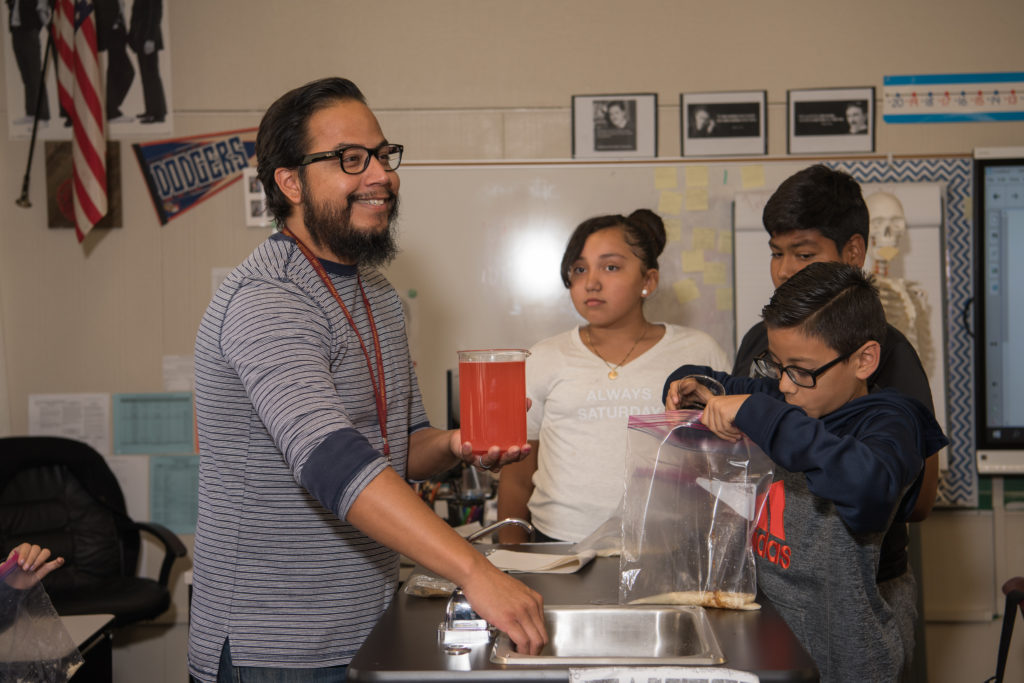Photos by Kim Sanford
Students put crackers and bread pieces inside plastic baggies, add water, squish, and watch how the mixture clumps. When food is chewed in the mouth and goes down the esophagus, it looks like that, explains Juan Padilla, a sixth grade teacher at Jefferson Academy in Hanford and a member of the Hanford Elementary Teachers Association. Next, to simulate stomach acid breaking down food on its way to the small intestine, students add coffee to the concoction. Some of the mixture is poured into containers of fake blood, demonstrating how nutrients enter the bloodstream and become absorbed.
The youngsters work in groups, pouring and mixing, clustered
around four portable science labs that contain sinks. Eventually students are
told to cut the bottom corner of the baggie and squeeze out the concoction, to
show how the large intestine helps food depart from the body.
“Oh my god, it’s poop,” the students cry delightedly.

This type of hands-on experiment to implement the Next
Generation Science Standards was impossible until last year, due to the
configuration of desks and no counter space. Then Padilla thought of creating
portable science labs on wheels, equipped with microscopes, petri dishes,
slides, cylinder sets, gram scales, test tubes, pipettes and even fire
extinguishers. CTA’s Institute for Teaching funded the project with a grant of
nearly $20,000.
“Students are definitely much more enthusiastic about
science,” says Padilla. “Before, science was hypothetical. Now students do
experiments in real time. It’s more exciting. Students are not just studying
science — they see themselves as scientists.”
For students, science has never been so enjoyable.
“Mr. Padilla always has interesting experiments and makes
learning fun,” says Gianna Garcia. “You never know what’s going to happen.”
There was fanfare and excitement when the portable labs were
rolled out last year, recalls Padilla. “Kids came in and said, ‘Oh my gosh,
we’re going to do real experiments now!’ The principal and learning director
walked in and said, ‘Wow, this looks like a real science classroom with all the
bells and whistles.’ Other teachers on-site were thrilled because, of course,
it’s all about sharing.” The labs easily roll into other classrooms.
“Parents came and saw students looking at their own cells
under a microscope, and there was definitely a wow factor.”
In Hanford, an agricultural town near Fresno, half the
residents are Latino, and many are struggling financially. So it’s crucial that
students have the same opportunities as those in more affluent communities, to
prepare them for jobs of the future, says Padilla.
“So many jobs in the future will be science-focused. This gets students thinking about those types of careers,” says Padilla. “Many of them will want to pursue science as a career. I sense that in them. And I think the labs will definitely help.”
Our 2019-2020 Innovation Issue
Juan Padilla is one of the innovative educators we highlight this year. Meet the rest:
- Jennifer Barry guides Special Ed students in work and life skills
- Sherinda Bryant teaches English through a social justice lens
- James Gensaw helps Native American youth connect to their culture
- Somphane Hunter creates community in the kitchen
- Daniel & Dennis Gibbs set a STEM career path for students
- Becky McKinney builds relationships; students learn NGSS along the way
- Jorge Perez creates an oasis of scientific excellence at community college
Padilla, who has been teaching at Jefferson Academy since
2007, identifies with his students. He moved to Hanford in third grade and
never left, except for attending Fresno Pacific University.
“I was an English learner, and there was not a lot of
inclusion during that time,” he recalls. “I was put in a separate class and
felt targeted. In college, a professor made it a point to always check in with
me and kept tabs on me. That was rare at the university level. I try to
replicate that with the little guys and be that kind of a teacher. It’s my
motivation.”
Padilla created a sports science elective that incorporates
the portable labs. Athletes love it because they learn about sports; science
nerds love the data. It has brought all types of students together, and it’s so
popular there’s a waiting list.
“You come to a point in your teaching career when it’s time
to make things more interesting, branch out and find a way to reach every
student,” says Padilla. “Innovation is exciting. It’s fun. It can be scary. For
me, it’s all about getting out of my comfort zone.”
See cta.org/JuanPadillaIFT to view our video.
The Discussion 0 comments Post a Comment